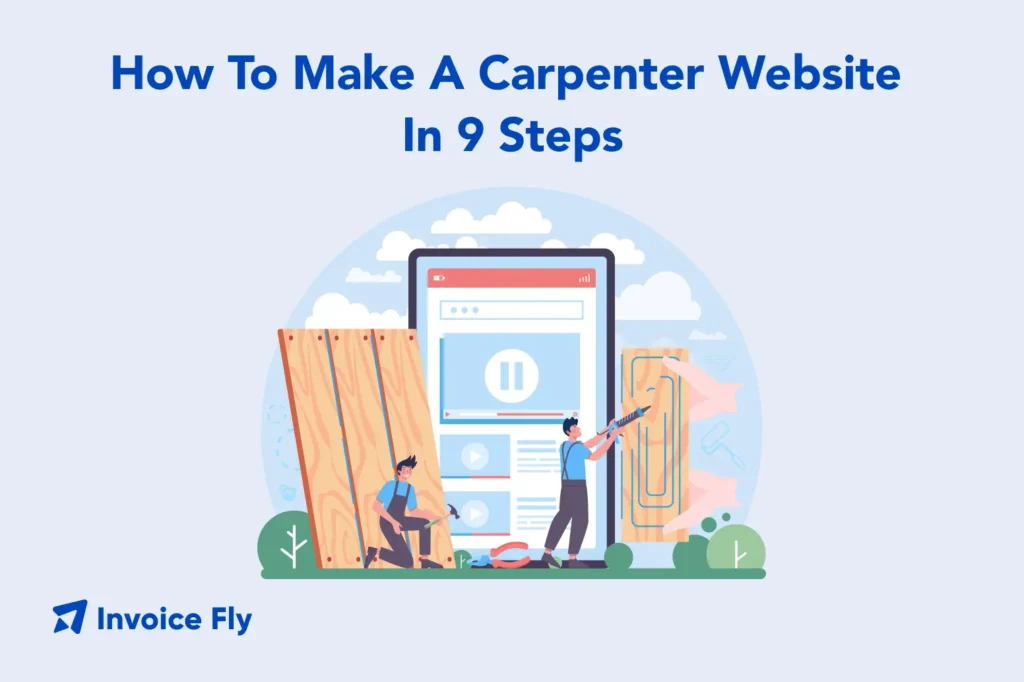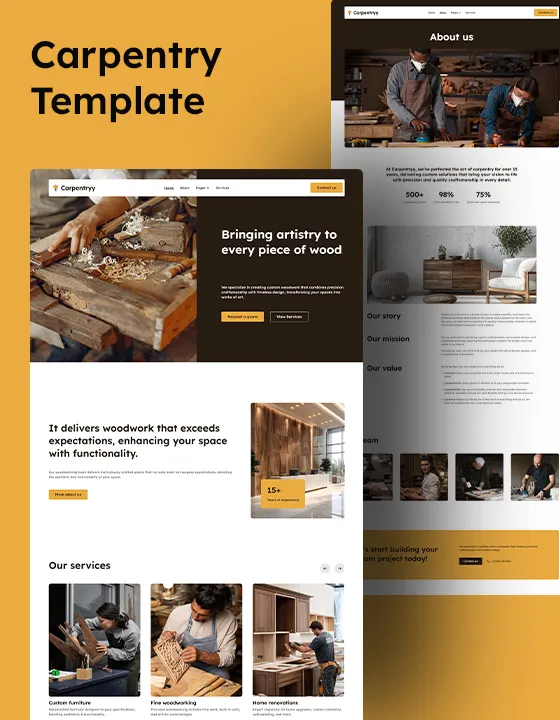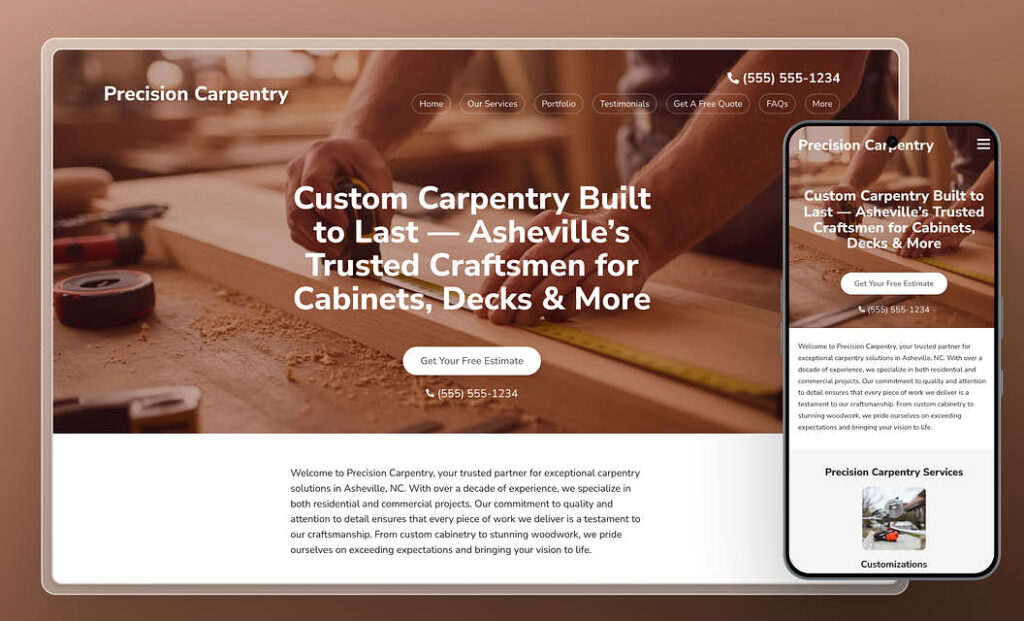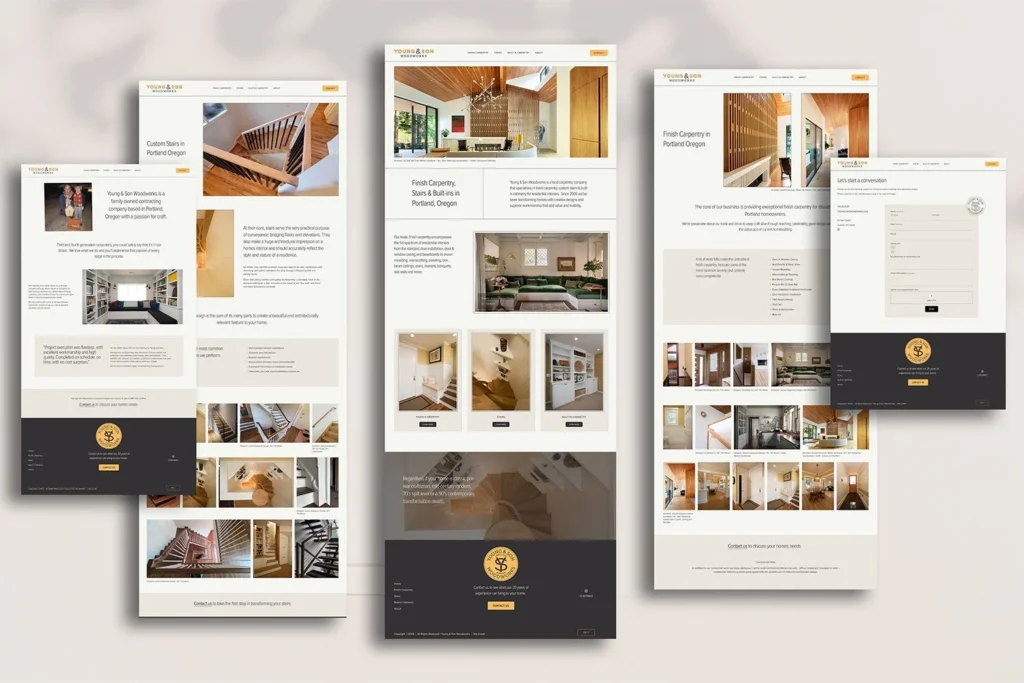How To Make A Carpenter Website In 9 Steps

Table of Contents
Building a carpenter website is one of the most effective ways to showcase your craftsmanship, attract new clients, and grow your carpentry business. With a professional site, you can display your portfolio, highlight your services, and make it easy for potential customers to contact you. Even if you’re not a tech expert, today’s website builders make it simple to launch a polished, user-friendly site.
In this guide, we’ll walk you through nine steps to make a carpenter website from scratch. You’ll learn how to choose a domain, pick a builder, design your pages, optimize for SEO, and promote your services. By the end, you’ll have a fully functional carpenter website that helps you stand out in a competitive market.
Need a simple way to handle invoices once your website brings in clients? Try Invoice Fly’s Invoicing Software. It’s free to start!

What is a carpenter website?
A carpenter website is essentially your digital storefront. Just as you wouldn’t invite clients into a messy workshop (we hope!), you want your online space to be organized, attractive, and welcoming. It’s where potential customers come to learn more about your services, see examples of your past projects, and decide if you’re the right professional for their needs.
For carpenters, this type of site often plays several roles. It acts as a portfolio, showcasing photos of woodworking and finish carpentry projects. It provides a services list so people know exactly what you offer—whether that’s furniture building, custom cabinetry, or full-scale home renovations. It can include testimonials from satisfied clients to build trust. And, of course, it makes contacting you easy with a dedicated landing page or contact form.
The beauty of a carpenter website is that it’s available 24/7, even while you’re in the workshop. Platforms like Wix, Webflow, Squarespace, and WordPress make this simple even if you’re new to web design.
If you’re just getting started as a professional, you may also want to check out our guide on how to start a carpentry business.

Source: Serve Grow
How to make a carpenter website in 9 steps
1. Decide your website’s purpose and pages
Before diving into setup, take a step back and think about what you want your website to achieve. Do you want to attract local homeowners searching for finish carpentry, sell custom furniture nationwide, or build authority as a woodworking expert? Defining your main goal will shape everything from your design choices to the type of content you publish.
Once you know your purpose, map out the essential pages your carpenter website should include:
- Homepage: A welcoming introduction to your carpentry services with a clear call to action.
- About page: Share your story, background, and what sets your craft apart.
- Services page: Outline what you offer in detail. Not sure what to include? Check out our guide on the best carpentry services to offer in 2025.
- Pricing page: Help clients understand your process by being transparent. Our resource on how to quote carpentry work can give you ideas.
- Portfolio: Showcase your best projects with high-quality photos and descriptions.
- Contact page: Make it easy for clients to reach you through a form, phone number, or email.
- Testimonials page: Highlight reviews and feedback from happy clients to build trust.
- Blog (bonus page): Share project spotlights, carpentry tips, or industry insights. A blog not only positions you as an expert but also improves your website’s SEO by giving search engines fresh content to index. Just be prepared to keep it up-to-date!
By covering these basics, your carpenter website will give visitors a complete picture of who you are, what you offer, and why they should work with you.

2. Buy a domain name and web hosting service
Your domain name is the web address people will type in to find you, like www.johnscarpentry.com. A good domain should be short, memorable, and easy to spell. Whenever possible, include a keyword like “carpentry” or “woodworks” so search engines can instantly recognize what your business is about.
Hosting is where your website’s files live. Many builders such as Wix and Squarespace include hosting in their plans, making setup seamless. If you choose WordPress, you’ll need a third-party provider like Bluehost or SiteGround, unless you choose their all-in-one service. When comparing hosting, look at speed, security, and customer support—these factors all affect your site’s reliability.
3. Choose a website builder and template
Not all carpenters are tech-savvy, and that’s okay. A carpentry website builder is the easiest way to design a site without writing code. Popular choices include Webflow for custom branding, Squarespace for sleek templates, and WordPress if you want ultimate control.
Once you’ve chosen a platform, start with a contractor website template or webflow template. Templates save time and give you a professional look right out of the box. Look for themes that emphasize large images and clean navigation so your craftsmanship can shine. Many builders offer html templates specifically designed for contractors and craftspeople.

Source: Webflow
AI and Carpenter Websites
Website building in 2025 has taken a huge leap forward thanks to artificial intelligence (AI). Tools like Wix ADI (Artificial Design Intelligence), Squarespace’s AI-powered design assistant, and Webflow’s AI experiments now make it possible to create a tailored carpenter website in minutes.
AI can speed up the process by generating layouts, choosing fonts, and even suggesting content ideas. For carpenters, this means less time wrestling with design choices and more time focusing on client work. You can get a polished, mobile-ready site that looks like it was built by a pro—then tweak it to add your personal brand.
4. Customize your carpenter website design
Once you have a template or theme, make it your own. Choose colors that reflect your brand—wood tones and earthy hues often work well for carpentry. Pick fonts that are professional but easy to read. Upload your logo and make sure it’s displayed consistently in the header and footer.
One of the most important aspects today is mobile optimization. According to Statista, more than 60% of internet traffic comes from mobile devices. So your site should look just as good on a phone as it does on a desktop. Test your pages on multiple devices and adjust spacing or image sizes if needed.

Source: Zarla
If design feels overwhelming, remember that many tools allow you to start simple and build up over time. Platforms like Squarespace are especially beginner-friendly.
5. Showcase your services and portfolio
This is where your website really earns its keep. Potential clients want to know exactly what you can do, and nothing convinces them faster than seeing your past work. Create a dedicated services page where you clearly list what you offer, from custom carpentry and furniture design to home repairs.
On your portfolio page, upload high-quality images that show your range of skills. Organize projects by category so visitors can easily find what they’re looking for. Consider creating a compelling landing page for your most popular services. If you’re comfortable, consider listing approximate prices or offering a “request a quote” button to encourage inquiries. Transparency builds trust and saves time for both you and your clients.

Source: Jodi Neudfeld
You can also expand your brand with a blog. Posts about the best carpentry tools to use on the job or project tutorials show off your expertise while bringing in more traffic.
6. Highlight your client testimonials
Word-of-mouth has always been one of the most effective marketing tools for carpenters. Bringing that same power online is easy with a testimonials page or section. Ask past clients to provide a few sentences about their experience, and display these quotes alongside photos of the finished work if possible.
You can also pull in reviews from platforms like Google or Yelp to add credibility. Positive feedback not only reassures potential clients but also sets you apart from competitors who may not showcase reviews.
7. Optimize for search engines (SEO)
A beautiful site won’t generate new leads if people can’t find it. That’s where SEO (Search Engine Optimization) comes in. For carpenters, local SEO is especially important. Use keywords like “custom carpenter in Chicago” or “kitchen cabinets Boston” to attract clients searching in your area. Make sure your city and service area are listed clearly on your site.
Local SEO
Focus on location-based keywords and ensure your business name, address, and phone number are consistent across all pages. Create location-specific landing pages if you serve multiple cities or regions.
Google Business Profile
Don’t forget to claim and update your Google Business Profile. This free tool helps you show up on Google Maps and boosts your visibility in local searches. Regularly updating your website with fresh content, like blog posts about recent projects, can also improve rankings.
8. Promote your carpenter website
Once your carpenter website is live, let the world know. Share the link on social media platforms like Instagram, Facebook, and LinkedIn. Post before-and-after pictures of your projects to grab attention. If you want to speed up growth, consider running Google Ads for search terms like “finish carpentry near me.”
Partnerships are another powerful strategy. Connect with interior designers, real estate agents, or home renovation companies who can refer clients to you. Attending local trade shows or home improvement events is another way to promote your services while directing interested people to your website.
9. Tracking and maintaining your carpenter website
A website isn’t a “set it and forget it” project. To get the most value, you need to track performance and keep it updated. Use Google Analytics or the built-in tools in your website builder to see which pages get the most traffic and how visitors behave on your site.
Regularly update your portfolio with new projects, fix any broken links, and refresh outdated information like prices or contact details. If you’re using WordPress, make sure to update plugins and themes to keep your site secure. Think of maintenance as the digital equivalent of sharpening your tools—small steps that ensure everything continues running smoothly.
For financial tracking of your business, consider integrating tools like QuickBooks for comprehensive financial analysis, Stripe for payment processing and cash flow management, or Wave Apps for small business accounting needs.
Carpenter website examples
A great way to get inspired for your own carpenter website is to see how others present their craft online. Here are four standout examples, each built on a different platform:
- Lindauer (Squarespace): Specializing in ecological kitchens, Lindauer uses a clean, minimalist Squarespace design with smooth image sliders and a masonry grid that puts their craftsmanship front and center.
- Sanko Custom Carpentry (WordPress): Built on WordPress, this site combines large, high-resolution images with blog updates to showcase both projects and expertise.
- Notch Artisan Builders (Wix): Notch’s Wix site features a modern, monochrome style with a bold hero image that instantly communicates their professional brand.
- Edifis (Webflow): Edifis uses Webflow for a highly interactive experience, with 3D models, parallax effects, and video backgrounds that highlight innovation.
Visit Wix’s carpenter website guide for more carpenter website examples.
Which carpenter website builder is best?
There are many platforms to choose from, but four stand out for carpenters. Each offers unique strengths depending on your budget, goals, and how hands-on you want to be with customization.
| Feature | Wix | Webflow | Squarespace | WordPress |
| Ease of use | Very easy | Moderate | Easy | Moderate to hard |
| Best for | Beginners & small carpentry shops | Custom branding & control | Small shops & solo carpenters | Large-scale / highly custom sites |
| Templates | Large library of carpenter-friendly templates | Professional & modern | Sleek & stylish | Thousands of themes |
| Cost | ~$17–$159/month (annual billing) | Site plans from ~$14–$39+/month | ~$16–$52/month (annual billing) | Hosting from ~$2.99/month + domain $10–20/yr |
| SEO tools | Built-in SEO wizard + AI tools | Advanced controls | Built-in basics | Plugins (Yoast, RankMath) |
Wix is ideal if you want a quick, beginner-friendly option with lots of templates and AI tools to help you get started. Squarespace is a great choice for solo carpenters or small shops that want stylish, modern designs without too much setup. WordPress is best suited for larger carpentry businesses that need scalability, advanced customization, or a blog-heavy site—but it requires more setup and ongoing management.
Why you need a carpenter website
Clients expect businesses to have an online presence. Without a site, you risk losing work to competitors. A carpenter website lets you:
- Showcase your work 24/7
- Attract new leads through SEO
- Build credibility with testimonials
It also helps you stand out from competitors who might not have a website or whose sites are outdated. And since your site is available at all hours, clients can browse your portfolio and contact you whenever it’s convenient for them.
Tip: If you’re just starting out, check out our guide on how to start a carpentry business and our list of 200+ carpentry company names for inspiration.
Final Thoughts
Your carpenter website is a powerful marketing tool that can help you land more clients and grow your carpentry business. With the right carpentry website builder and a clear strategy, you can create a site that reflects your craftsmanship and makes it easy for customers to choose you.
Whether you’re showcasing custom carpentry work or highlighting your woodworking expertise, the right combination of design, content, and functionality will set you apart from the competition. Remember that your website works 24/7, attracting potential clients even while you’re in the workshop or meeting with other customers.
The investment in a professional carpenter website pays dividends over time, establishing credibility and providing a centralized hub where clients can learn about your services and get in touch.
Need a payment processing solution for your carpentry business? Try Invoice Fly’s Invoicing Software. It’s free!
FAQs about Carpenter Websites
Yes. With website builders like Wix, Squarespace, or Webflow, you don't need coding skills to create a professional site using contractor website templates.
Absolutely. Many carpenters build their own websites in just a weekend using themes and templates from their chosen carpentry website builder.
Focus on SEO, share your work on social media, and highlight testimonials on your site to build trust. Create compelling landing pages for your services. For more strategies, see our carpenter job description guide and learn about carpenter salary expectations to better position your services.
You can start free with Wix or WordPress, but for a professional site with the best carpenter website design, you'll need to invest in hosting and a domain.
Yes! Tools like Wix ADI and Squarespace's AI assistants can design layouts, generate content, and optimize your site automatically using various html templates and themes.
